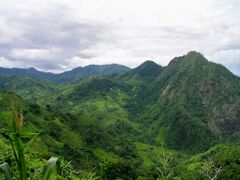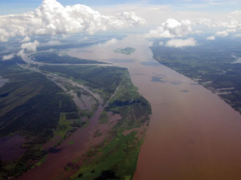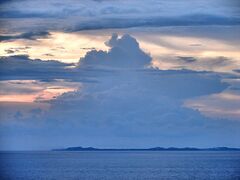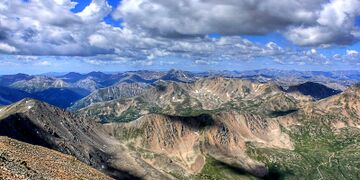Istrenya
This article is a work-in-progress because it is incomplete and pending further input from an author. Note: The contents of this article are not considered canonical and may be inaccurate. Please comment on this article's talk page to share your input, comments and questions. |
Republic of Istrenya | |
|---|---|
Motto: "Aqua'aani sovakal shatapo'oleeka" "From the Mountains to the Shores" | |
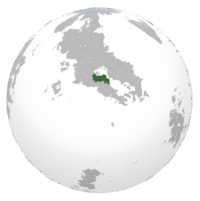 Location of Istrenya (dark green) In Crona (gray) | |
| Capital and largest city | Karaba |
| Official languages | Sokalakee Qabóri |
| Demonym(s) | Istrenyan |
| Government | Democratic Republic |
• President | M'Kole Tysh'le |
• Vice President | L'tore Yaruba |
| Legislature | National Congress |
| Establishment | |
• Woqalate of Sokalakee | 311 – 776 |
• Annexation by Qabór | January 9, 777 |
• Independence from Qabór | March 4, 1335 |
• Istrenyan Crisis | 1959–1961 |
• Current constitution | August 22, 1961 |
| Population | |
• Estimate | 32,124,217 |
| GDP (nominal) | estimate |
• Total | $525 billion |
• Per capita | 16,342.81 |
| Currency | Istrenyan Pound (Î) |
| Time zone | UTC—10:00 to UTC—08:00 |
| Mains electricity | 120 V–60 Hz |
| Driving side | right |
| Calling code | +332 |
| Internet TLD | .is |
Istrenya, officially the Republic of Istrenya, is a country in Crona. It is neighbored by Arcerion and Malentine Islands across the Warrington Strait, along with sharing a sizable land border on the south portion with Tierrador. By area is is one of the largest Indigenous countries in South Crona, and one of the most populous. With a population of 32 million, it is one of the least populous countries in South Crona, only being slightly more populous than Asteria and Porlos. The national capital is the city of Karaba, which is also the nation's economic centre and the largest non-Occidental port in the Malentine Sea, largely due to trade from across the Warrington Strait coming from Arcerion.
Seated at the foothills and lowlands North of the South Istrenyan Mountain Range, Istrenya was largely comprised of disparate river and mountain tribes as far back as 50,000 years ago. Closer to the modern and industrial era, Occidental colonists and traders established trading posts across the Warrington Strait, which eventually became the basis in the late 1700s and early 1800s for the city of Karaba. The following century saw an expansion of trading to the nearby towns of Madara and Sumbe, in the Eastern River Basin, where the majority of the nation's economic and industrial centres remain to this day.
Istrenya was never officially colonized or controlled by foreign powers, unlike many of its neighbours, owing to its poor geographic location and the favourable conditions in the Eastern Malentine where Ardmore and other Occidental countries were investing in the rapidly expanding Arcerion. Throughout its history, Istrenya mostly served as a vassal state for Imperial Tierrador. Istrenya's independence was threatened during the 1956 Istrenyan Crisis where communist and socialist rebels attempted to overthrow the nation, and Arcer intervention prevented the Populist national government from being toppled and replaced by left-wing red factions based out of the Western half of Istrenya. The following conflict with Tierrador in the Mosquito War did not help either, leaving a lot of destruction in its way. The lasting effects of the Civil War and Mosquito War are felt today, with the nation ethnically split between Eastern and Western cultural and tribal lines, the Eastern half regularly trades and entreats with Arcerion, whereas the West continually sees Arcerion as meddling in Indigenous affairs and violating the nation's sovereignty.
Istrenya is not particularly rich in natural resources or agriculture, mostly having a small fishing trade and some mining for raw materials in the Southern Mountains. Karaba's port is the most important Western Indigenous maritime port, servicing much of the country's needs. The next two largest cities, Madara and Mogtepeni both have disparate industries, the former being agrarian owing to its location in the Eastern River Basin, and the latter being a mining town mostly controlled by private Arcer corporations. Istrenya's largest exports are agricultural products, raw materials and raw minerals, over half of which are imported into Arcerion for refining and sold as finished goods. The human development of Istrenya has remained historically low throughout the 20th and 21st centuries, especially in the Western half of the nation. Istrenya has also been host to a large number of Varshani refugees after the Final War of the Deluge.
Etymology
Before its independence in 1335, Istrenya was historically referred to as Sokalakee. The ruling class of Imperial Istrenya as a vassal state of the Qabóri Woqalate was the indigenous Sokalakee Tribe, therefore whenever diplomatic relations were commenced between Istrenya and Tierrador during that period of time, they were referred to as the Sokalakee Woqalate. Following the nation's independence from the Qabóri in the 1300s, Ardmori settlers discovered the land during Aster's expedition and dubbed it "Istrenya". The origin of this name is unclear, however many scholars believe the name was derived from several mistranslations of the Sokalakee language to Ænglish, and the term "Istrenya" was agreed upon as a placeholder for both parties.
Geography
-
The Southern Mountain Range of Istrenya.
-
The Eastern River Basin of Istrenya, which opens into the city of Karaba.
-
The Malentine Channel the separates Istrenya from Malentina.
-
Iraso Township in Western Istrenya.
-
Istrenyan Highlands.
-
Karaba Bay.
Istrenya is a moderately-sized country, being one of the largest in the South Cronan Peninsula. It is slightly larger than Ceylonia but smaller than South Sakartvelos. The country only has one land border, in the southern portion of the nation, which is primarily shared with Tierrador. Similar to its southern neighbor, Istrenya possesses a subtropical climate, with mostly warm, wet, and humid summers along with moderately-temperatured winters. The eastern part of the nation is dominated by the river basin from the Blue River, while the western part is dominated by many smaller rivers (such as the Tafao, Bošia, Qasin, and Tsava Rivers), whose basins spread across 80% of the country's land. The Blue River is Istrenya's primary access to the Orixtal Sea, and medium-sized ships containing goods from Istrenya regularly travel through Tierrador onto the Orixtal Sea, though not very often due to the more preferable option being the Songun Sea. Its southern border is primarily dominated by the Qalhéq Mountain Range, and in this area, temperatures can drop quite low during the winters. Its climate, along with its position on the Songun Sea and the Blue River basin allowing for lush, arable land, capable of producing long and prosperous harvest seasons.
Istrenya's major population centers are typically situated on the northern coastal region of the nations. The nation's capital and largest city of Karaba is situated on the Warrington Strait, about 450 miles from Kurst in Arcerion. The five largest cities (Karaba, Madara, Iraso, Enunana, and Lokojela) are in the northern part of the country, where 65% of the country's population reside in. Istrenya shares a close maritime border with the Malentine Islands, through the Iraso Channel. Because of this, many immigrants from Malentina reside in the northwestern corner of Istrenya, and vice versa.
The Istrenyan portion of the Qalhéq Mountains are dubbed as the Istrenyan Highlands. This region, in the southern part of the country, is mostly dominated by small, rural villages. Only 2%, or 640,000 Istrenyans, live in these small villages. Karaba is situated on the Karaba Bay, where the Port of Karaba serves as an economic hub for Istrenya. Karaba is home to over 3 million Istrenyans, the most populated and densest populated city in Istrenya. The Port of Karaba was constructed in 1981, funded by foreign investors from Arcerion and Tierrador, and slightly boosted the nation's economy throughout the 1980s.
History
Pre-Qabóri period
It is unclear when Istrenya was first inhabited, however most historians and scholars agree that the first inhabitants of the land migrated from Central/North Crona, truly originating from Audonia. This had occurred around the same time as the first inhabitants of Tierrador and Porlos, with Ceylonia being inhabited shortly after, around 1250 BC - 1000 BC. Istrenya had become a haven for agricultural settlements, and these settlements quickly evolved into large chiefdoms. The earliest known complex civilization of Istrenya was the Sokalakee civilization, which had originated in the Istrenyan Highlands and quickly spread north to the country's plains, where it started the aforementioned permanent agricultural settlements. Around the beginning of the 1st century AD saw the rise of the Qabóri Woqalate, which had become the pinnacle of South Cronan civilization. At first, Sokalakee rarely interacted with Qabór, owing to the massive Qalhéq Mountains serving as a natural barrier between the two civilizations. Eventually, as Sokalakee evolved as a civilization so did its foreign interaction, bartering various agricultural products with its much more powerful neighbor.
In 311 AD, the Sokalakee had formed its first government, borrowing its methods of organization and governance from Qabór. The Sokalakee Woqalate was formed as a result, and comprised of all of modern-day Istrenya. The Woqalate based its government in the city of Kruabia, at the foot of the Istrenyan Highlands near the eastern coast. Kruaiba was considered one of the largest cities in South Crona, and its establishment as a cultural hub earned it the nickname "North Qabór." While the Qabóri Woqalate had been in a long conflict of interest with the Abio Woqalate for nearly 600 years, Sokalakee stayed neutral for the first few hundred years, though favoring the Qabóri over the Abio.
Arrival of Qabór
Qabóri influence began to increase significantly during the first few centuries AD. With the end of the Great Qabóri War and the fall of the Abio Woqalate in 677, the rising Qabóri Woqalate began to shift its focus on surrounding neighbors. Sokalakee, having entered numerous economic and military defense agreements with Qabór, which had began the first wave of complete subjugation by Qabór. In 777, Sokalakee had been completely taken over by the Qabóri Woqalate, being divided into 21 qoyalets, based on the tribal makeup of the area. The Woqalate had continued its fair dealings with the Sokalakee tribes, giving the qoyalets some form of autonomy not seen in other Qabóri colonies. By the 9th and 10th centuries, Sokalakee had helped to expand Qabór's sphere of influence to all of South Crona, while also enjoying the benefits with little to no exploitation. In 1033, the small Songun city of Karaba was founded, and was designated as the main government center of Qabóri Sokalakee.
While Sokalakee was among one of the most guarded areas in South Crona, they were still vulnerable to attacks from foreign powers. The North Songun civilization, which had dominated the North Songun Peninsula, directly rivaled Qabór and its vassals, despite being not as technologically advanced as the former. Depsite this, North Songun outnumbered Qabór, and was able to expend thousands of troops to project their true power. In 1122, North Songunite troops crossed the Malentine Straits into Karaba, where they sacked the city in just three days. This was an unexpected attack on Qabór, and completely caught it off guard, therefore they did not have ample time to react. Once they prepared the Qabóri Army to counterattack, a sizable chunk of northern Istrenya had been conquered through brute force. However, the North Songunite victory would be overshadowed by the swift and surprising Qabóri counterattack. Qabór had sent around 6,000 soldiers to fight alongside the Sokalakee defenses. This had also marked the first use of guns used in war by Qabór. The vast difference in technological advancements had allowed Qabór and Sokalakee to swiftly take down the North Songunite army, and forced a retreat back to their peninsula.
After the war had ended, Sokalakee had suffered major losses and underwent a major rebuilding period. While Qabór offered assistance in the process, it was not nearly enough for the sheer amount of ruin the colony had seen. This strained the relations between Qabór and Sokalakee, and served as a major catalyst to the colony's independence. Towards the beginning of the 12th century, Sokalakee had begun demanding more support from Qabór, especially considering the disparity of aid given to Yapokee and Soqweux in comparison to Sokalakee. The argument was that Sokalakee was practically being neglected by Qabór, due to the colony not having much to offer, as opposed to the vast resource pools seen in the Yapokee and Soqweux colonies. This, along with the prolonged consequences of the war against the North Songunites, led to heightened anti-Qabóri sentiment across the colony. In 1267, using Qabóri weapons and military technology, Sokalakee warriors stormed the palace in which the colonial government was based. This began the 10-year long Sokalakee Revolution, which culminated in the withdrawal of Qabór from Istrenya and the establishment of the independent Sokalakee Woqalate.
Sokalakee Woqalate
The new Sokalakee Woqalate was established in 1277, with many issues afoot. They mostly included the mass divide between the many subgroups and tribes throughout the country, as most of the groups, which mostly inhabited the rural areas, supported Qabóri integration more than independence due to the several benefits of trade with the more advanced empire. Once Qabór had cut ties with Sokalakee, and shut down all trade to and from, it diminished any incentive for the agricultural settlements to produce up to their quota, as the rewards were either minimal or nonexistent. The beginning of the 14th century saw the Woqalate at its worst, as the divide had only grown, with no solution in sight. The Woqali of Sokalakee, at the time Aukl'e I until her death in 1345, practically neglected her duties as the monarch of the country. This had strained the relationship between the Sokalekee nobility and the proletariat, causing a rift in the Sokalakee culture and society. In June 1343, members from the contesting House of Tkolúúta had confidentially instigated the peasant class of Karaba to storm the Woqali's palace in Karaba, in one of several major insurrections to occur in the 1340s. There, the peasants captured several Sokalakee military generals and held them hostage for four months, while they continued on with the mass insurrections, hoping to depose the ruling House of Wteke'la.
While the chaos in Karaba had surged, the neighboring Matokté Tashcanate had grown as an even larger threat to the stability of Sokalakee. In response, the House of Tkolúúta implemented itself as the ruling dynasty of Sokalakee. The most powerful figurehead in the House, Taka'tila I, became the Woqali, and ordered the House of Wteke'la be exiled to present-day Malentina, where they remained for the next half-century. Taka'tila's reign as Woqali would only last for a few years, and she would eventually die of an unknown illness in 1352. Her successor, Taka'tila II, was very inexperienced at her position, leading to many faults in military campaigns against rogue qoyalets. In 1357, the first wave of Matokté warriors crossed the Malentine Straits into Karaba, where they completely destroyed the city. The next couple of sackings by the Matokté were spread out carefully so that the Sokalakee would not have ample time to rebuild and regroup, giving the nomadic Tashcanate a major advantage in the conflicts. Taka'tila II's inexperience as a political figurehead allowed her to be easily manipulated by her generals into giving them full control of the Sokalakee military. Despite this, the generals were equally inexperienced, and were mostly using Qabóri tactics and strategies, which were grossly misinterpreted due to the lack of communication from Qabór, and left many soldiers confused and caused internal conflict amongst the Sokalakee armies. This was exactly what the Matokté hoped would happen, and it only increased their advantages tenfold.
As Matokté presence grew significantly in Istrenya, many Sokalakee towns and villages saw the same fate as Karaba, and by the end of the 14th century, 75% of Istrenya had been assimilated into Matokté proper. Many Sokalakee nobles fled to the Istrenyan Highlands, and the Woqalate continued as a small pocket of land throughout the southern border with modern-day Tierrador.
Early Modern
Arcer influence begins
Istrenyan Civil War
Late Modern
Mosquito War
2009 Rice Riots
Beginning in December 2008, the Istrenyan National Congress began unloading a series of harsh agricultural reforms, which included the lowering and even elimination of the minimum support price of several crops. Because of this, hundreds of thousands of Istrenyan farmers began protesting the agricultural reforms, with many labor unions prompting them to go on strike until the reforms were reversed. This led to a mass shortage of agricultural products throughout the country, with food prices skyrocketing to nearly double of what they were pre-reform. Because of this, the Istrenyan Heartland Movement was established by Tierradorian activists in late February 2009, with over 1.1 million Tierradorian citizens participating in donating leftover food to Istrenyans who were affected the most by the shortages. In April 2009, a leaked audio file of then-President K'wola Tatarni mocking the protesting Istrenyan farmers and the protest as a whole, causing mass outrage throughout the country. Later that month, police in major Istrenyan cities began arresting and using brute force against protesting farmers. This turned what was originally meant to be peaceful into violent riots. These riots were one of the largest cases of civil unrests in Istrenyan history. The Istrenyan government declared martial law in June 2009, and deployed the Istrenyan Army into various Istrenyan cites to deter the riots. Following harsh international pressure, President Tatarni resigned from office in late August 2009, and was replaced by current President M'Kole Tysh'le. Tysh'le reversed many of the reforms, and negotiated the reinstatement of a lower, but still sustainable, minimum support price with the farmers, effectively ending the Rice Riots in October of that year.
Contemporary Istrenya
Government
Istrenya is a presidential constitutional republic. It is governed via principles established by the 1961 Constitution, which features the aforementioned presidential system, a unicameral legislative body, known as the National Congress, which represents the population of Istrenya at-large, and a judicial branch, which consists of the Istrenyan High Court. Despite many of the rights outlined in the 1961 Constitution, most of the political power in the country is held by the executive branch, more specifically by the President of Istrenya. The country is a unitary state, separated into 21 qoyalets. The qoyalets, despite not having strong governments, still maintain control over petty bureaucratic affairs within their jurisdiction.
Executive
Most of the power in Istrenya is vested in the executive branch of the government. Since 2014, there have been pushes to establish a checks and balances system within the government, however despite all of the progress that has been made, there is still a large gap between the executive branch and the rest of the government. The current President of Istrenya is M’Kole Tysh’le, who has been in power since 2025. The president is usually selected through a free election process, which occurs every four years since 1961. Every Istrenyan National over the age of 17 is required to cast a vote in the presidential election, incurring a fine of 550 Istrenyan Pounds (or $150) for not participating. The president of Istrenya is the commander-in-chief of the Istrenyan military, is able to issue an suspensive veto to legislative bills before they become law, which the National Congress would be unable to override, and appoints the members of the Executive Offices along with other government officials, who administer and enforce Istrenyan laws and policies through their respective agencies. The Constitution does not mention term limits for the president, therefore it is common to see Istrenyan presidents serving until death.
Legislature
The legislative branch of Istrenya is mainly composed of the National Congress, a unicameral legislature which is responsible for drafting, deciding, and enforcing legislations throughout the entire country. As of 2035, there are 331 representatives serving in the National Congress. Elections for the National Congress take place in the same cycle as the presidential election, however the National Congress elections take place in the winter of that election year, as opposed to the presidential election taking place in the spring of said year. Similar to the presidential election, all Istrenyan nationals are required to vote, however the penalty for not voting in this election is less severe, only incurring a fine of 100 Istrenyan Pounds (or around $30). Unlike the president, the 1961 Constitution establishes limits of three 4-year terms, or 12 years, for representatives of the National Congress, however it is very rare to see a representative serve more than two full terms.
Local governance
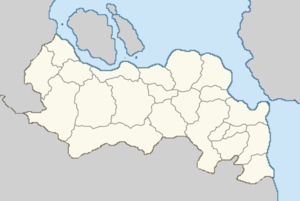
Istrenya, like most Qabóri-influenced nations, calls its administration subdivisions qoyalets, which is the Qabóri word for "province." There are 21 of these qoyalets in Istrenya. Istrenya is a unitary state, though there is a substantial amount of autonomy for the qoyalets. Historically, the qoyalets have rarely changed since Qabóri subjugation, owing to various subgroups of the four major tribes of the country. The qoyalets are governed by a three-branch system, similar to the central Istrenyan government. The qoyalets have an elected qoyalet legislature, which are directly-elected via popular vote within the respective qoyalet, along with a non-partisan premier, appointed directly by the President of Istrenya. The qoyalet legislature supervises elected officials, debates and votes on budgets, plan regional development, execute public investment projects, promote economic activities, and manage public property.
Society
Istrenyan culture is significantly impacted by its location, as the country historically served as a crossroads of the cultural influences of Tierradorian and Ænglish traditions. Mainstream Istrenyan culture is a mix between the South Cronan indigenous culture, mostly stemming from centuries of Qabóri influence, and, more recently, Ængle culture, specifically that of Arcerion. Despite being closer to Arcerion politically, Istrenya is more culturally tied to Tierrador, with most elements of Istrenyan daily life barring near-perfect similarities to its southern neighbor. Since the 1950s, Istrenyan media, mostly music and film, became very widespread and mainstream throughout South Crona. Despite this, the cultural divide between indigenous Cronans and Istrenyan Ængles has negatively impacted the country’s day-to-day life.
Cuisine
Istrenyan cuisine is influenced by local agriculture. Since there is a large presence of grain farming in Istrenya, bread and noodles are of importance and Istrenyan cuisine has been characterized as "noodle-rich". Istrenyan cuisine is also corn and pepper-based, due to those being highly-cultivated crops throughout the country. Kokelá is a traditional Istrenyan noodle soup which is made from chicken, corn, garlic, and onion. It is very popular throughout South Crona, usually served as a day-to-day meal.
Sport
The most popular sport in Istrenya is football. There are over 13 million players registered with 76,000 sports clubs. The Istrenyan Football Federation is the governing body for the sport in Istrenya. The IFF has had a very controversial past, with them bearing the responsibility of the Istrenyan national football team being banned from three UCFA Cronan Championships along with the 2002 WAFF World Cup. Besides this, the Istrenyan national team has seen some success, the most notable being the team’s victory in the 2011 UCFA Cronan Championship, losing to Canespa, 1–0, in the final. The Istrenyan Premier League is contested by eighteen teams, and is the highest level of football in the country. Qapitol Karaba and FC 1957 Lokokeja are the two most successful clubs, with 27 and 23 IPL titles, respectively.
Despite the majority of the nation being in a particularly warm climate, ice hockey is the second most popular sport in Istrenya. Hockey is watched by 10 million Istrenyans, which is almost one-third of the country’s population. The country has one OHL club, the Karaba Mountaineers, which began play in 1998 and is the most popular Istrenyan hockey team. Istrenya also has a major junior hockey league, the Istrenyan Hockey League, which is contested by 18 teams and is one of the four leagues of the South Cronan Hockey League, which serves as a direct feeder league to the OHL Draft. Some notable Istrenyan OHL players include Akolá Tuka, L’Kelek Chavez, Aphío Waso’k, and Fred Y’kasak. Other notable Istrenyan OHL personnel include Levar Xirótin, who is of Coscivian descent and serves as the head coach for the Wadičaq Phantoms.
Demographics
As of 2035, Istrenya has an estimated population of 32,167,499. The country is an outlier in terms of development, being one of the least developed countries in South Crona, with some areas of the country having one of the highest rates of poverty in the region. Despite this, Istrenya has relatively stable natural population growth, and efforts have been made to assist lower-income communities throughout the country. As of October 2031, Istrenya's fertility rate declined slightly to 1.72 children per woman, below the replacement rate of 2.04, and considerably below the high of 3.19 in 1940. Istrenya's fertility rate and crude birth rate nonetheless remain among the highest in South Crona. Istrenya has a very young population as well, with the average age being 32.6 years, along with one-fifth of the country being younger than 40. The average life expectancy is relatively high despite its shortcomings in development, at about 71.9 years.
Ethnic groups
Istrenya is mostly dominated by Indigenous Cronans, with 82% reporting ancestry from multiple tribes.
Language
Economy
In 2030, Istrenya had a gross domestic product of $525 billion. Its top trading partners are Arcerion, Tierrador, Porlos, and Ceylonia. While Istrenya is not as rich in natural resources as other South Cronan nations, it does possess a sizable quantity of petroleum and lithium. In 1998, Istrenya brokered the Lithium Deal with Tierrador, which allowed Tierradorian miners to enter the country and extract lithium. This deal did not last long, however, as international pressure from Arcerion and Alstin forced the deal to end in 2002. Many critics argue that the current Istrenyan state is merely a client state of Arcerion, due to Arcer dominance of the Istrenyan GDP. Istrenya is considered a developing country, though has made very significant steps towards full development in the past two decades. The increased economic influence from Tierrador has helped boost the country's economy in numerous ways. The nation's GDP has seen consistent growth since the 2000s, allowing it to become a more liberalized economy. Istrenya's economy is categorized as a mixed economy, still with sizable amounts of government influence. The nation's vast economic growth has begun an upward trend in terms of economic growth and fiscal stability. Despite this, a large portion of the country's economy relies heavily on remittances, due to many Istrenyans in the workforce going to work overseas.
Industries and International Trade
Istrenya's five largest economic sectors are agriculture, raw mineral extraction, fishing, petroleum, and livestock. Agriculture is the backbone of Istrenya's economy and has traditionally dominated the economy, employing about 40% of the workforce as of 2018. Istrenya has historically been considered an agrarian society, due to its historical reliance on crops and farmland because of its extremely arable location. The country is known for producing bananas, grapes, melons, and several other fresh and dry fruits. It is also known as one the world's largest producer of cotton – as much as 16% or more of the nation's economy is derived from the cultivation and sale of cotton. It is also one of the world's top producers of cannabis, historically exporting a large majority of it to Tierrador. This caused decades of political complications between the two culturally similar nations, as cannabis was illegal in Tierrador until 1992.
Mining is the second largest industry in the country, with 22% of the nation's workforce being employed in the industry. Most of Istrenya's exports are dependent on mineral resources, accounting for 41% of the country's exports. The country has the world's 4th largest lithium reserve, the 8th largest sulfur reserve, and several undisclosed but efficient reserves of iron ore, sodium, zinc and silver reserves. Most of the nation's mineral exports go to Tierrador and Arcerion. The Tierradorian mining company Auqali Lithium is the largest employer in the Istrenyan mining industry, with approximately 122,000 Istrenyan employees. Istrenya also has some of the largest petroleum and natural gas reserves in South Crona. Istrenyan petroleum prices are some of the lowest in the world due to that industry being one of the most heavily subsidized in the country and in the world. Istrenco is an Arcer-Istrenyan petroleum drilling company, and it is the largest producer of petroleum in the country. It owns hundreds of drilling platforms in the Songun Sea and the Warrington Strait. Istrenya mostly exports its oil to Arcerion.
Tourism in Istrenya is also on the rise. Historically, Istrenya was regarded as a dangerous nation for most Occidental tourists. However, as the country became more politically stabilized, it saw a steep rise of tourists in the mid to late 2000s. In 2033, Istrenya saw close to 3.8 million visitors, making it the fourth-most visited country in South Crona. The most popular tourist destination is Karaba, due to the cultural significance of the city. Many indigenous Cronan tourists visit the city for the Qabóri New Year, as it hosts one of the largest festivals in South Crona for the holiday. Most tourists also visit the southern mountains of Istrenya, due to its elevation creating perfect conditions for skiing. The Kowokela Ski Resort, located on the border of the Koungheul Province and the Ulunkheria commonwealth of Tierrador, is the largest of many ski resorts across the southwestern border of the two nations.
Transportation
Energy
Military
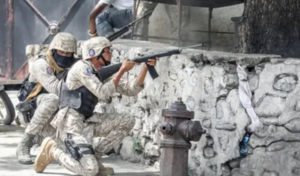
The Istrenyan military is relatively small, and has continued to shrink since the Istrenyan Civil War. The Army doubles in its role as a national gendarmerie, and lacks much of the heavy equipment, radios, and modern weaponry in order to be an effective fighting force. Concurrent to this, the military has long been plagued by corruption amongst its senior officials and been unable to procure new equipment, relying instead on international aid of intervention by Arcerion when there is issues with insurgents, subversive groups, or rebels.
Currently, the military is organized into three divisions (1st, 2nd, and 3rd) each with three infantry brigades and supporting units such as artillery, engineers, signals, and artillery. The Army lacks tanks and heavy armored fighting vehicles, instead relying on an aging fleet of armoured cars, trucks, and jeeps that in some cases pre-date the 1956 Civil War. The Army uses a variety of foreign-acquired weapons meaning that logistically it is difficult to resupply or maintain its current arsenals. All of these problems are combined with poor pay and low morale, and ethnic divisions within the Army are high as the majority of its officers and NCOs are drawn from more economically prosperous and stable Eastern Tribes, whereas the rank and file conscripts are majority Western.
The Istrenyan Air Force oeprates a few small fixed winged aircraft, mostly in the reconnaissance role, as well as light-strike. The majority of these are converted civilian aircraft, and the few fighter jets the national procured in the 1980s have fallen into a state of disrepair and have not been seen to have been airborne since the early 2000s. It possesses a few small lighter civilian-pattern helicopters for VIP transport and limited troop lift.
The Istrenyan Navy has patrol vessels and coastal cutters, and conducts mostly commerce protection, revenue services, and anti-piracy, working in conjunction with others in the Malentine Sea such as the Royal Arcer Naval Service. It has a pair of aging former Varshani frigates from the 1960s but they are often seen rusting and unable to leave port under their own power.


